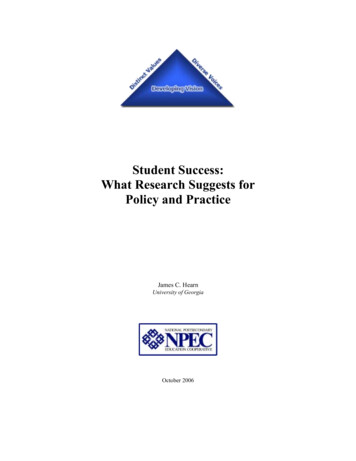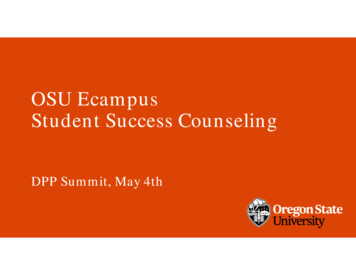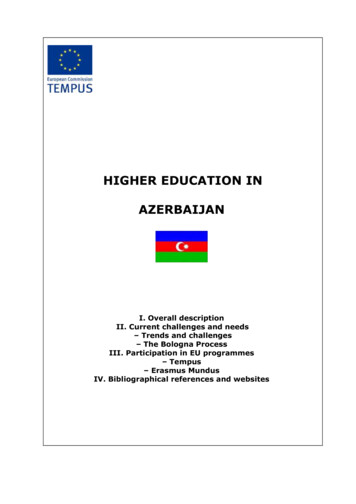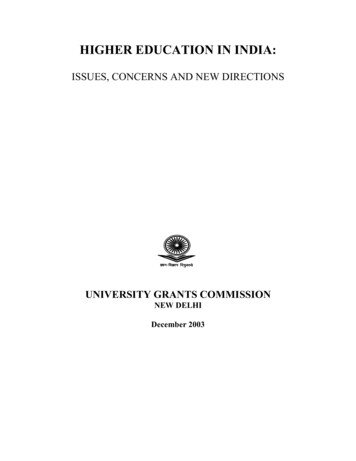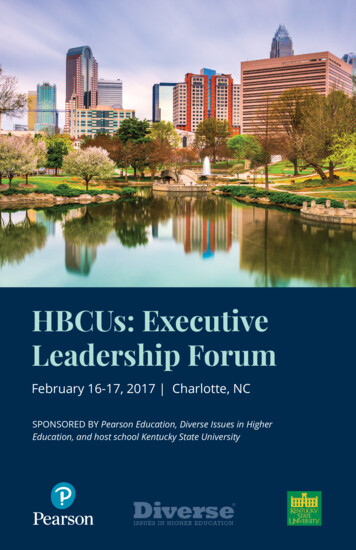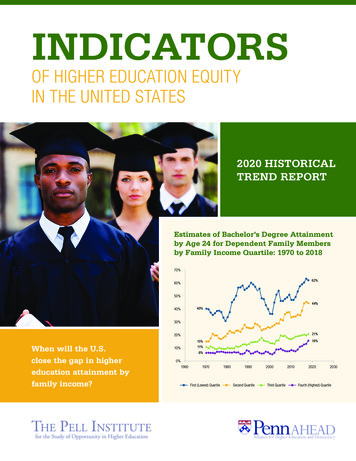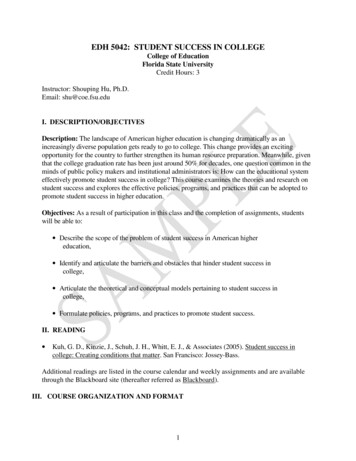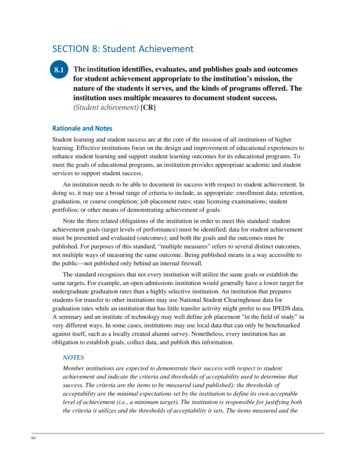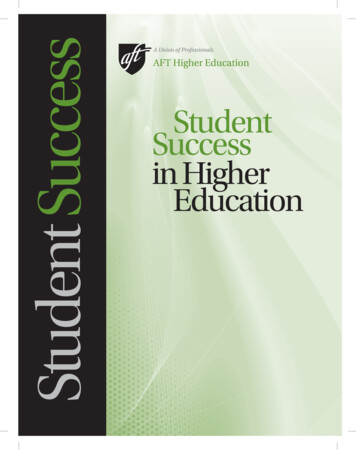
Transcription
Student SuccessStudentSuccessin HigherEducation
A Division of the American Federation of TeachersRANDI WEINGARTEN, PresidentAntonia Cortese, Secretary-TreasurerLORRETTA JOHNSON, Executive Vice PresidentHigher Education Program and Policy CouncilChair: SANDRA SCHROEDER, AFT Vice President, AFT WashingtonVice Chair: DERRYN MOTEN, Alabama State University Faculty-Staff AllianceBARBARA BOWEN, AFT Vice President, Professional Staff Congress, City University of New YorkPHILLIP SMITH, AFT Vice President, United University Professions, State University of New YorkTOM AUXTER, United Faculty of FloridaJASON BLANK, Rhode Island College Chapter/AFTELAINE BOBROVE, United Adjunct Faculty of New JerseyORA JAMES BOUEY, United University Professions, SUNYPERRY BUCKLEY, Cook County College Teachers UnionJOHN BRAXTON, Faculty & Staff Federation of the Community College of PhiladelphiaCHARLES CLARKE, Monroe Community College Faculty AssociationADRIENNE EATON, Rutgers Council of AAUP ChaptersFRANK ESPINOZA, San Jose/Evergreen Faculty AssociationCARL FRIEDLANDER, Los Angeles College Faculty GuildJAMES GRIFFITH, University of Massachusetts Faculty FederationBONNIE HALLORAN, Lecturers’ Employee OrganizationMARTIN HITTELMAN, California Federation of TeachersARTHUR HOCHNER, Temple Association of University ProfessionalsKRISTEN INTEMANN, Associated Faculty of Montana State, BozemanBRIAN KENNEDY, AFT-WisconsinHEIDI LAWSON, Graduate Employees’ Organization, University of Illinois-ChicagoJOHN McDONALD, Henry Ford Community College Federation of TeachersGREG MULCAHY, Minnesota State College FacultyMARK RICHARD, United Faculty of Miami-Dade CollegeDAVID RIVES, AFT OregonJULIETTE ROMANO, United College Employees of the Fashion Institute of TechnologyELLEN SCHULER MAUK, Faculty Association at Suffolk Community CollegeELINOR SULLIVAN, University Professionals of IllinoisDONNA SWANSON, Central New Mexico Employee UnionNICHOLAS YOVNELLO, Council of New Jersey State College LocalsAFT Higher Education StaffLAWRENCE N. GOLD, DirectorCRAIG P. SMITH, Deputy DirectorLINDSAY A. HENCH, Senior AssociateCHRISTOPHER GOFF, AssociateLISA HANDON, Administrative AssistantKEVIN WASHINGTON, Administrative Assistant 2011 American Federation of Teachers, afl-cio (AFT). Permission is hereby granted to reproduce and distributecopies of this work for nonprofit educational purposes, provided that copies are distributed at or below cost, and thatthe author, source and copyright notice are included on each copy.
ForewordThe most critical issue facing highereducation today is how to provide access toinstruction and services that will enable manymore students to fulfill their postsecondaryaspirations. Education, being both a public and a privategood, brings together many of the forces of change in oursociety and creates vast and unceasing debate. The paperyou are about to read, prepared by the higher educationleadership of the American Federation of Teachers(AFT), states what we think needs to be done to helpcollege students achieve educational success. The AFTis a national union of 1.5 million members that includesapproximately 175,000 faculty and professional staffmembers in the nation’s colleges and universities.As chairwoman of the national AFT Higher Educationprogram and policy council, I invite you to engage in ourdiscussion and in activities that will result from it. As thepresident of AFT Washington, a previous president of AFTSeattle Community College, Local 1789 and as a part-time,then a full-time professor of English at my institution, Ihave had unique opportunities to observe faculty, staff,administrations, education bureaucracies and studentsat their work. I know that we want to work together forthe common good—the good of our profession, ourinstitutions and the people we teach.But that is far from all of it. The AFT is also a union whichbelieves that advancing the interests of our membersmeans furthering their professional as well as theireconomic objectives—and it is not an exaggeration tosay that student success is what AFT Higher Educationmembers are all about. Making a difference in the lives ofstudents is why faculty and staff members choose to be inthe academy, why they go to work each day, why they keepup with the latest scholarship in their disciplines, why theyspend so much time meeting with students and assessingtheir work. Day in and day out, the nation’s collegefaculty and staff demonstrate a high level of personaland professional commitment to students, to highereducation, to their communities and to the future of theworld we live in. The following report is issued in the spiritof that commitment.Sandra SchroederMarch 2011As a leader of a representative union, I understand theunion’s responsibility to further the interests of ourmembers. A large part of that consists of working to ensurethat the labor of AFT members is well compensated andthat their employment conditions are fair, secure andrewarding.STUDENT SUCCESS 1
Executive SummaryTHE FOLLOWING THREE PAGES PROVIDE AN OVERVIEW OF AFT HIGHER EDUCATION’S PLAN TO HELPSTUDENTS LEARN HOW TO GET MORE OUT OF THEIR COLLEGE EXPERIENCE.2 A F T h i g h e r educat i o n
In 2010, aft president randi weingarten and theunion’s college and university leadership began planning an initiative to demonstrate the union’s ongoingcommitment to place student success at the center ofits higher education agenda. The initiative, still in its earlystages, reflects and draws upon the work of our members,the frontline faculty and staff who make a positive difference in the lives of their students every day. It also drawsupon what students tell us they want and need from theircollege experience, reinforced by the results of student focus groups conducted for AFT to launch the initiative.College student success is a major issue today in government and policy circles. AFT members agree that a renewedemphasis on student success is critical because, as President Obama stresses, the number of students with a collegeeducation is not as high as it should be, and college studentretention rates are not as high as any educator would wantthem to be. The gap in college student success among various racial and ethnic groups also is unacceptably large.A major aim of the student success initiative is to moreeffectively bring the voice of frontline faculty and staff—along with their knowledge of pedagogy and their experience with students—into the growing policy debateover college curriculum, teaching and assessment. Thework began by conducting the student focus groups andengaging with key policymakers and experts in the field.Other initial aspects of the initiative include the development of a national website and data center on studentsuccess issues (www.whatshouldcount.org)and an effort to help AFT Higher Education affiliatesconsider developing activities oriented toward studentsuccess on their own campuses. The report you are aboutto read is an important component of the initiative, representing the union’s first effort to delineate key elementsof college student success, to suggest ways to implementeffective programs, and to outline the roles and responsibilities of all higher education stakeholders in achievingstudent success.Origins—and Shortcomings—of theNational Focus on Student SuccessMuch of the attention in higher education policy circlestoday is focused on how to help more students gain access to higher education and then succeed by attaininga degree or certificate. Over the years, most of the workfocused on the access side of the equation, particularly onensuring an adequate level of federal student aid as well asstate institutional support. Now, in the face of dwindlingpublic resources, the policy debate has increasingly shifted from “access” to “success” issues, such as retention andevidence of learning outcomes—in other words, to whathappens to students after they enter college. The generalemphasis has been on holding institutions accountable forachieving measurable outputs—like high graduation ratesand standardized test scores—and on developing variouscurriculum frameworks. However, AFT members believethere are some significant problems in today’s public discourse about accountability and outcomes. First, on the technical level, there are very seriousproblems with the federal formula for computing graduation rates and with the validity of various testing measuresand their impact on the curriculum. Second, too many policy discussions of student success avoid serious consideration of financial factors, asthough investment in learning is not connected to studentsuccess. To the contrary—the at-risk population of nontraditional students who participated in the recent AFT focusgroups demonstrates the intricate connection betweenstudent success and resources. These students report, forexample, that paying for college is just about the biggestobstacle they face in completing their studies. Concernsabout finances also lead students to work too many hours,which hampers their chances for success. Finally, students report that large class sizes, limited course offeringsand difficulty in getting enough personal attention fromoverworked faculty and staff are key obstacles to theirachievement. Third, too many policy discussions about accountability have failed to incorporate the views and experiencesof frontline faculty and staff. The AFT believes that thedisengagement between workers on the ground and theaccountability movement needs to be addressed if we areto achieve positive and lasting results for students.Approaching Student SuccessHow, then, should the academy approach today’s studentsuccess issues? First, the work must begin with a shared understandingat the institutional level of how student success is to be defined. AFT members approach student success in broaderSTUDENT SUCCESS 3
terms than quick degree attainment or high standardizedtest scores—they usually define student success as theachievement of the student’s own, often developing, education goals. Our members not only teach students who maybe on track to obtain degrees or certificates, but they alsoteach students who are looking primarily for job trainingwithout earning a formal credential or for the acquisitionof professional skills to enhance their career opportunities.Other students are studying academic subjects strictly forlearning’s sake. Adding to the complexity, students oftenadjust their goals throughout their college years. For thesereasons, measuring student success solely in terms ofdegree attainment reflects a misunderstanding of today’sacademy. To understand the realities of student success, wemust begin to identify ways to elicit information on studentgoals throughout the educational process and to ensurethat reliable data on student goals are fed back into the curriculum development and assessment processes. It is alsoimportant—and specifically called for by the students whoparticipated in our focus groups—to ensure that studentshave multiple opportunities to assess and reassess theirgoals through a rich process of advisement or counseling. Second, campus discussions on student successshould be undertaken with a clear recognition of thethoughtful work on curriculum and assessment alreadygoing on at most campuses, and with a commitment notto be perpetually reinventing the wheel. Third, once a broad understanding of student successis achieved, professionals at the institutional level need tocollaborate systematically on curriculum and assessmentin accordance with this understanding—, with faculty andprofessional staff in the lead. Because institutional missions and student bodies are so diverse, and because itis important to capitalize on the mix of faculty expertiseparticular to each institution, the AFT believes that planning for student success should be conducted at the institutional level rather than across institutions or at the stateor national levels. In this regard, our members reject theidea that institutional outputs can be compared easily likethe ingredients on a cereal box. The one constant in highereducation is diversity, not uniformity, and diversity is alsoits greatest strength. Fourth, collaboration should proceed with an understanding that frontline faculty members and staff shoulddrive the processes of curriculum development, teachingand assessment to ensure that education practices are effective and practical in the real-life classroom.The AFT student success report delineates a number ofcommon elements of student success cutting across dif-4 A F T h i g h e r educat i o nferent programs and disciplines that the union believescan be viewed as a framework for the type of educationalexperience all students should have in some form. Thoseelements, described in greater detail in the report, include: Exposure to knowledge in a variety of areas; The development of intellectual abilities necessaryfor gathering information and processing it; and Applied skills, both professional and technical. Theseelements are laid out in a chart on page XX.In our view, these elements offer one acceptable framework (certainly not the only one) to focus professionalthinking, collaboration and planning around curriculum,teaching and assessment. In any case, however, the specific categories and details are not the most importantthing. The most important thing is to have a deliberativeand intentional perspective among individual facultymembers and the institution’s body of faculty based onadvance planning and collaboration—and also on theevidence from focus groups that students want and benefitfrom a high degree of clarity and interconnection in theircoursework.ImplementationTo ensure that curriculum and assessment materialstranslate into real gains for students, the report recommends that: Faculty should be responsible for leading discussionsabout how the elements of student success are further articulated and refined to help students at their institution succeed. The implementation process should respect the principles of academic freedom. Professional staff should be closely involved in theprocess, particularly with regard to how the elementswill be articulated vis-à-vis academic advising and careercounseling. Implementing common elements for student successnot only should respect differences among disciplines andprograms, but also should strive for an integrated educational experience for students. New curriculum frameworks, assessments or accountability mechanisms should not re-create the wheel; Assessing the effectiveness of this process should focus on student success, academic programs and studentservices but should not be used to evaluate the performance of individual faculty or staff.
Roles, Responsibilities andAccountabilityAFT members overwhelmingly favor reasonableaccountability mechanisms; they also believe thataccountability needs to flow naturally from clearlydelineated responsibilities, including the responsibilityfaculty and staff have in the learning process. It takesthe work of many stakeholders to produce a successfuleducational experience. Each stakeholder has uniqueresponsibilities as well as a shared responsibility towork collaboratively with the other stakeholders. Thisreport puts forward a listing of roles and responsibilitiesfocused on four groups of stakeholders—faculty andstaff members, institutional administrators, studentsand government. Under this kind of rubric, individualstakeholders have clear responsibilities for which theycan be held accountable, and no individual stakeholder issolely responsible for achieving ends only partly in his orher control.3. Institute or expand student success criteria alongthe lines of the student success elements describedearlier (or an equally valid one). This is best basedon deliberate, multidisciplinary planning in individualinstitutions led by frontline faculty and staff. Giventhat another one of students’ most called-for needs isassistance with developing a clear path toward theireducation goals, the aim is to provide clarity to theeducational experience for students along with otherstakeholders, including government and the generalpublic.4. Coordinate learning objectives with studentassessment. The desire to compare learning acrossdifferent institutions on a single scale is understandable.However, we believe that student learning would bediminished, not enhanced, by administering nationalassessments that overly homogenize “success” to what iseasily measurable and comparable.5. Provide greater government funding and reassessMuch of the policy debate on accountability has beentied to the idea that college attainment and completionrates are too low. Even though the measurement ofgraduation rates is deeply flawed, AFT members fullyagree that retention is not what it should be and thatsome action must be taken to improve the situation. Ourrecommendations include:current expenditure policies to increase support forinstruction and staffing. We cannot expect studentsuccess when institutions are not devoting resourcesto a healthy staffing system and are allowing students’education to be built on the exploitation of contingentlabor and the loss of full-time jobs. The system of highereducation finance needs to be re-examined so collegesand universities can fulfill the nation’s higher educationattainment goals.1. Strengthen preparation in preK-12 by increasing6. Improve the longitudinal tracking of students asRetention and Attainmentthe public support provided to school systems and theprofessionals who work in them. As noted earlier, collegefaculty and staff at the postsecondary and preK-12 levelsshould be provided financial and professional supportto coordinate standards between the two systems andminimize disjunctions.they make their way through the educational system andout into the world beyond. The current federal graduationformula is much too narrow. We need to look at allstudents over a more substantial period of time, and wehave to take into account the great diversity in studentgoals if we are to account properly for student success.2. Strengthen federal and state student assistanceIn conclusion, the AFT believes that academic unions,working with other stakeholders, can play a central rolein promoting student success. Making lasting progress,however, will have to begin at tables where faculty andstaff members hold a position of respect and leadership.This student success report is scarcely the last word onthe subject—it is, in fact, the union’s first word on thesubject, and we expect many ideas presented here tobe refined in conversations all over the country. Theimportant thing is that those conversations about studentsuccess start taking place in many more places than theyare today.so students can afford to enter college and remainwith their studies despite other obligations. Again,students report that paying for college is an overwhelmingchallenge, and that they must work a significant numberof hours to support their academic career, often at theexpense of fully benefiting from their classes. We cannotexpect to keep balancing the books in higher educationby charging students out-of-reach tuition and dismantlinggovernment and institutional support for a healthy systemof academic staffing.STUDENT SUCCESS 5
The National DiscussionHalf a century ago, the united states undertook a historic commitmentto make an affordable college education available to all Americans, regardlessof their financial means. At the federal level, this commitment led to the establishment of a structure of student financial assistance that has grown more and moreelaborate over the years. At the state level, the commitment to college access for all resulted in the opening and funding of thousands of public universities and communitycolleges. Hundreds of thousands of college students, most of whom would never havebeen able to attend college in another era, have taken successful advantage of these policies. The federal and state commitment to public higher education has been one of theclearest public policy successes in American history.Today, more students than ever are attending communitycolleges and universities. There has been a recent upsurgein college enrollment spurred in part by the state of theeconomy from 2008 to 2010. At the same time, however,the ability of public higher education to accommodategrowing enrollment has been handicapped in criticalways. College costs continue to rise. State and localgovernments have decreased their level of investmentin public colleges and universities, and institutions haveresponded by cutting back the share of spending directedto instruction. Government disinvestment has resulted inhigher tuitions which, in turn, have left students assumingunreasonable levels of debt to attend college and, worse,prevented many from enrolling altogether or persisting intheir studies. Funding for federal student assistance, untiljust recently, failed to keep pace with rising costs, and therecent gains made to the federal Pell Grant program arealways in danger of being rolled back. Students from racialand ethnic minorities and other first-generation collegestudents have suffered most from these inadequacies.With enrollments on the rise and without a comparablepublic investment in higher education, the capacity ofpublic colleges and universities to serve students is now6 A F T h i g h e r educat i o nstrained beyond the limit. Unfortunately, it is becomingcommonplace to see academic programs curtailed oreliminated and corners being cut on student servicesin an attempt to maintain a “bare bones” budget. Tomeet the influx of students, instructional staffing is beingbuilt increasingly on a part-time and full-time corpsof “contingent” faculty members without permanentjobs and without basic economic and professionalsupports. America is no longer the world leader in collegeattainment. Student retention rates are far lower thaneducators want or the nation should accept.At the same time, one fact is still incontrovertible:Most people who complete a postsecondary degree orcertificate program1 do better in every aspect of their lives.In March 2004, the national average total personal incomeof workers 25 and older with a bachelor’s degree was 48,417, roughly 23,000 higher than for those with a highschool diploma. For those with an associate’s degree, theaverage total personal income of workers 25 and older was 32,470, still 7,400 more than those with a high school1. See, for instance, The Investment Payoff: A 50-State Analysis ofthe Public and Private Benefits of Higher Education (2005) by theInstitute for Higher Education Policy.
diploma .2 Providing greater opportunities for studentsfrom all walks of life to succeed in college needs to be a topissue on the national agenda.Recognizing the growing importance of a collegeeducation, it is not surprising that public discussion anddebate about student success issues is at an all-timehigh. This has been driven in part by the strong priorityplaced on higher education by the Obama administration.Overall, the emphasis on student success is a positivedevelopment. Our members fully agree that studentretention is not as high as it should be, and they are eagerto play a leading role in improving conditions.However, with growing alarm, many of us have beenfollowing today’s policy debates about student successissues such as curriculum, assessment and accountability.Unfortunately, some of the fevered discussion on thissubject has not been as constructive as it could be, nor asgrounded in the experiences of frontline educators as itshould be. When it comes to generating solutions to theproblems facing students and colleges, we have seen tooheavy an emphasis on solutions that are overly simplisticand fail to address the reality on campus.Too often, AFT members see proposals put forward tomeasure things because they are measurable, not becausethey really tell us anything new or important about theeducational program. For example, our members oftenwitness the imposition of “pay-for-performance” formulasthat define institutional success primarily in terms of ahigh graduation rate. This is problematic for a numberof reasons: first, because the graduation formula isnotoriously flawed (see inset) and also because pay-forperformance programs can create perverse incentives forinstitutions either to lower their educational standards(to achieve a higher graduation or job placement rate) or,conversely, to raise their entrance requirements so theycan “cherry pick” students who are likely to give them highgraduation numbers.There are further issues. One is the proliferation of accountability proposals designed around the perspective thathigher education can be seen and assessed through thesame lens as elementary and secondary education. In fact,the two levels of education are fundamentally different. Elementary and secondary education is mandatory and aimedprimarily at producing a somewhat uniform set of education outcomes grade by grade. Higher education, on theother hand, is pursued and paid for by adults who choose2. Ibid.FEDERAL GRADUATION RATE FORMULAThe most glaring example of the distancebetween policy and reality is the current federalgraduation-rate formula, which serves as the basisof a great deal of higher education policymaking.The problem is that the federal graduation formulafails to account for more than half of today’sundergraduates and therefore presents a skewedpicture of what is going on in the classroom,particularly at institutions serving large numbersof nontraditional students. No attainment formulacould capture all the nuances of student attainment,but the federal graduation-rate formula wouldbe much more accurate if it tracked students fora longer period of time and if it tracked part-timestudents, students who transfer from one college toanother, students who do not finish their degreeswithin 150 percent of the “normal” time, and themany students who are seeking neither a degreenor a certificate but who attend classes to pick upjob skills or for personal enrichment.institutions and programs to meet their own very diverseeducation and career goals. This diversity is a great strengthof American colleges and universities, and therefore ourmembers are concerned that overstandardizing assessmentwould weaken rather than strengthen education.In the same vein, a great deal of discussion aboutaccountability seems to focus on producing exactlycomparable data among all disciplines and all institutions.This perspective, in turn, has led to the generation of anumber of standardized student assessments despitevery mixed expert opinion of their reliability and value.3Too often, AFT members report that they are facing theimposition of standardized tests, which they believeto be divorced from the institution’s learning programand insensitive to the variety of education objectivesin different disciplines. For example, tests such asthe Collegiate Learning Assessment may offer somevaluable information pertaining to a particular sample ofstudents in a specific time or place. However, questionshave been raised about whether the CLA is a reliableassessment of the growth in student learning from oneyear to the next—our members are concerned aboutwhether it is appropriate to draw sweeping conclusions3. See Trudy Banta’s “A Warning on Measuring Learning Outcomes” (2007): NT SUCCESS 7
“What goes wrongwith so manycurriculum,teaching andassessmentproposals iscaused by the factthat classroomeducators.are notoften at the centerof the programdevelopmentprocess.”from student samples and employ those conclusions toevaluate institution-wide student learning and teacherperformance.The AFT believes that a lot of what goes wrong with somany curriculum, teaching and assessment proposalsis caused by the fact that classroom educators—alongwith their knowledge of pedagogy and experience withstudents—are not often at the center of the programdevelopment process. The perspective of frontlineeducators should assume a much more prominentrole in public discussion about student success andabout the most appropriate forms of accountability forassessing it.Frontline faculty and staff can contribute greatly to thedevelopment of policies that expand student access andsuccess while preserving the fundamental aspects of asuccessful college experience—a diverse offering of degreeand certificate programs in which students can learn inways that best suit them, one in which assessment andaccountability mechanisms support student learning asthe rich and complex experience we in the classroomknow it to be. We do not want to be left with a majorinvestment of resources that produces nothing more thana complicated, time-consuming maze of data that tellsus little or nothing of importance about student learningbut reorients college curricula to a lowest-commondenominator, teach-to-the-test curriculum.Finally, it seems clear that policymakers, policy analystsand frontline educators are often talking past one anotheron issues of student success and accountability or, morefrequently, not really talking at all. We need to breakdown these walls to search for the best solutions to thechallenges facing our students. Educators and all theother higher education stakeholders need to talk morefrequently and candidly about these issues with openminds and a willingness to consider different perspectives.8 A F T h i g h e r educat i o n
The Elements Of Student SuccessEveryone agrees that the higher education curriculum, teaching, assessmentand accountability all need to be focused squarely on student success. At the sametime, everyone does not agree on what student success actually means. Some analysts emphasize the achievement of a baccalaureate degree; others are engaged in a national drive to expand the number of com
college experience, reinforced by the results of student fo-cus groups conducted for AFT to launch the initiative. College student success is a major issue today in govern-ment and policy circles. AFT members agree that a renewed emphasis on student success is critical because, as Presi-dent obama stresses, the number of students with a college

